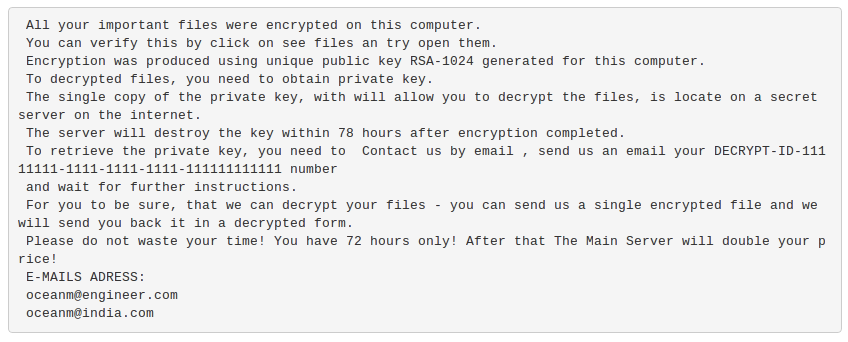Analysis Report on MOLE Ransomware
Early in 2017, Malware researcher Brad Duncan discovered MOLE Ransomware in the loose and now it has been updated with a new version named MOLE66 Ransomware. Indeed, nowadays, it is being distributed via spam emails containing fake information regarding USPS delivery having subject line as “Please recheck your delivery address” or “We’ve delivery problems with your parcel” or “Our USPS courier can’t contact your parcel”. The same spam emails also contains a shady link leading to a spamming website – bettermannow[.]com. The website displays an error message stating that a document can not be opened when you visit it and suggests you to download a plugin (actually a malware) in order to open the document file. When you get convinced and perform this action, your computer gets compromised with MOLE file encoder virus.

Following infiltrating your computer, the file encoder virus enciphers important files saved in commonly used data containers and renames them using an unique pattern presented as “[32_ransom_characters].MOLE”. For instance, sample.pptx will be transcoded as “7E95FSJFHKD0D15AAC484CF87B30D2F89077.MOLE”). Actually, files having the .MOLE extension become totally inaccessible and useless. Afterwards, the ransomware drops a text file named as “INSTRUCTION_FOR_HELPING_FILE_RECOVERY.TXT” on the desktop and also inside few folder having .MOLE suffix files. It provides informations regarding data encryption and also on how to get back files. According to the note, MOLE Ransomware uses RSA-1024 algorithms to encode important files and generate 1024-bit strong private key. At the time of writing, such key is nearly impossible to break-out. However, it is far better to make use of alternative options to restore files instead paying off ransom to threat actors.
How can you deal with MOLE Ransomware infection?
Dealing with MOLE Ransomware is really tough but if you could motivate yourself then our guidance can help you to get rid of the ransomware and restore files as well as preventing such attacks in future. As we mentioned, the file encoder is spread via spam emails, you shouldn’t double click spam emails attachments of links or install malware from untrustworthy sites. On the other hand, for restoring your files you can use System restore or Data recovery software which quite reliable. Most significantly, to keep your computer virus free, you have to install an efficient security software onto your computer. You must prefer to use PRO-versions instead using demo version cause only Pro-version provides real time protection against the ransomware. Now, you got all needful information, you should proceed MOLE Ransomware deletion guide immediately.
Free Scan your Windows PC to detect MOLE Ransomware
What To Do If Your PC Get Infected By MOLE Ransomware
The ransomware infection has been mainly designed with the purpose to scare users and trick their money. It take your files on hostage and demand ransom to return your important data. But now the question is what you can do when your system got infected by MOLE Ransomware virus? Here are some option that you can use to get rid of this nasty infection.
Don’t Panic – Well the first thing is Don’t panic and then completely check out your system for any working files. If you got any working files then copy it to USB drive.
Pay Ransom – Other option is you can pay the ransom and wait to get your files back. (really a bad option)
Use Backup – Clean you entire system files, remove the infection completely from your PC and restore your files with any backup.
Remove Infection – You can also delete MOLE Ransomware virus using malware removal tool and remove all the infected files. You can later recover all your data by using any data recovery tool. (In case you don’t have backup of your files.) – Recommended Method.
Reinstall Windows – The last option is reinstall your Windows OS. It will completely remove all your data as well as infection. You will get a completely new infection free PC.
How To Remove MOLE Ransomware Virus From Your PC
Step 1 – Boot your computer in Safe mode.
Step 2 – Remove the infected registry entry files.
- Click Windows Flag and R button together.

- Type “regedit” and click OK button

- Find and delete following entries.
HKEY_LOCAL_MACHINESOFTWAREsupWPM
HKEY_LOCAL_MACHINESYSTEMCurrentControlSetServicesWpm
HKEY_CURRENT_USERSoftwareMicrosoftInternet ExplorerMain “Default_Page_URL”
HKEY_LOCAL_Machine\Software\Classes\[MOLE Ransomware]
HKEY_CURRENT_USER\Software\Microsoft\Windows\CurrentVersion\Uninstall\[MOLE Ransomware]
Step 3 – Remove From msconfig
- Click Windows + R buttons simultaneously.

- Type msconfig and press Enter

- Go to Startup tab and uncheck all entries from unknown manufacturer.

Step 4 – Restart your computer normally.
Check your computer now. If the virus has gone then you can start using your computer. If the infection still remains then head to the next step.
Step 5 – System Restore
- Insert Windows installation disk to CD drive and restart your PC.
- While system startup, keep pressing F8 or F12 key to get boot options.
- Now select the boot from CD drive option to start your computer.
- Then after you will get the System Recovery Option on your screen.
- Select the System Restore option from the list.
- Choose a nearest system restore point when your PC was not infected.
- Now follow the option on your screen to Restore your computer.
If the above manual methods didn’t removed MOLE Ransomware virus then you have only option to remove infection using a malware removal tool. It is last and the only option that can easily and safely remove this nasty threat from your computer.
Having some alarming questions in your mind? Get your doubt cleared from our experienced tech support experts. Just go to the Ask Your Question section, fill in the details and your question. Our expert team will give you detailed reply about your query.




